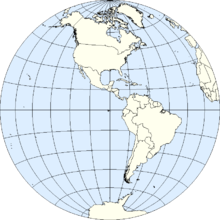Hemispheres of Earth
![]()
This article or subsequent section is not sufficiently supported by evidence (e.g., anecdotal evidence). Information without sufficient evidence may be removed in the near future. Please help Wikipedia by researching the information and adding good supporting evidence.
The prime meridian and longitude 180, which roughly corresponds to the International Date Line, divide the Earth into two hemispheres, the Western and Eastern Hemispheres. Unlike the northern and southern hemispheres, this division is not dictated by the Earth's geometry, but is determined by the prime meridian, which was internationally agreed upon in 1884.
Occasionally, for geoscientific purposes, the hemispheres are divided into two quadrants, each 90 degrees wide, but these quadrants do not have proper names but are described by their boundary meridians (e.g., "quadrant 90°W-180°").
According to this definition, Europe west of London, West Africa (including the Maghreb), most of the Atlantic, America and large parts of the Pacific belong to the Western Hemisphere. Overall, only about 15 percent of the world's population lives in the Western Hemisphere, while 85 percent lives in the Eastern Hemisphere, which includes Asia.
Today, the Western Hemisphere usually means the New World, i.e. the double continent of America and the surrounding islands of the Caribbean, among others, especially from the perspective of the Monroe Doctrine of the United States.
During the Cold War, the Western Hemisphere was defined as that part of the world that was aligned with the United States in its political principles or was a member of NATO.

The Eastern Hemisphere

The Western Hemisphere
See also
- Westfeste
- Eastern Festivals
- South Fest
Search within the encyclopedia